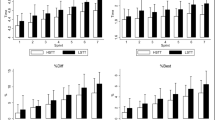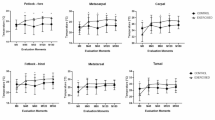Abstract
The aim of the study was to assess the impact of cryotherapy on changes of surface body temperate and efficiency of thermoregulatory processes in relation to the intensity of cryogenic stimuli. The study included 30 football players and 30 students. Intervention: both groups were divided into three subgroups treated with cryostimulation at −100, −120 and −140 °C. Body surface temperature was measured at baseline (before cryostimulation), 5 and 30 min after the treatment. Regions of trunk, lower limbs and upper limbs were examined. The difference of baseline raw curves and raw curves performed directly and 30 min after cryotherapy at the three levels of temperature in both studied groups. Baseline surface body temperature was lower in athletes than in student. Decrease in surface temperature observed after cryotherapy was significant and greater in football players than in students. The drop in surface temperature in athletes by 4.87° in the regions of upper limbs, trunk by 5.9 °C and lower limbs by 7.81 °C was reported. After 30-min restitution, the surface temperature restored to baseline in all subjects in all examined regions with greater dynamics in athletes. The study results indicate better effectiveness of thermoregulatory processes in football players. In this group, the greatest changes in temperature occurred after cryostimulation at temperature −120 °C. Further research is required to assess recommended values of thermal stimuli.





Similar content being viewed by others
References
Dębiec-Bąk A, Skrzek A, Podbielska H. Application of thermovision for estimation of the optimal and safe parameters of the whole body cryotherapy. J Therm Anal Calorim. 2013;111:1853–9.
Bleakley CM, Bieuzen F, Davison GW, et al. Whole-body cryotherapy: empirical evidence and theoretical perspectives. Open Access J Sports Med. 2014;5:25–36.
Pritchard KA, Saliba SA. Should athletes return to activity after cryotherapy? J Athl Train. 2014;49:95–6.
Sutkowy P, Augustynska B, Wozniak A, et al. Physical exercise combined with whole-body cryotherapy in evaluating the level of lipid peroxidation products and other oxidant stress indicators in kayakers. Oxid Med Cell Longev. 2014;2014:402631.
Ziemann E, Olek RA, Kujach S, et al. Five-day whole-body cryostimulation, blood inflammatory markers, and performance in high-ranking professional tennis players. J Athl Train. 2012;47:664–72.
Simmons GH, Wong BJ, Holowatz LA, et al. Changes in the control of skin blood flow with exercise training: Where do cutaneous vascular adaptations fit in? Exp Physiol. 2011;96:822–8.
Maughan RJ. Thermoregulatory aspects of performance. Exp Physiol. 2012;97:325–6.
Huda A, Taib S, Ghazali K, et al. A new thermographic NDT for condition monitoring of electrical components using ANN with confidence level analysis. ISA Trans. 2014;53(3):717–24.
Nardi I, Sfarra S, Ambrosini D. Quantitative thermography for the estimation of the u-value: state of the art and a case study. J Phys Conf Ser. 2014;547(1):1–8.
Bisegna F, Ambrosini D, Paoletti D, et al. A qualitative method for combining thermal imprints to emerging weak points of ancient wall structures by passive infrared thermography—a case study. J Cult Herit. 2014;15(2):199–202.
Sfarra S, Ibarra-Castanedo C, Paoletti D, et al. Infrared vision inspection of cultural heritage objects from the city of L’Aquila, Italy and its surroundings. Mater Eval. 2013;71(5):561–70.
El-Maadi A, Gregorie V, St-Laurent L, et al. Visible and infrared imagery for surveillance applications: software and hardware considerations. QIRT J. 2007;4(1):25–40.
Sfarra S, Perilli S, Paoletti D, et al. Ceramics and defects. Infrared thermography and numerical simulations—a wide-ranging view for quantitative analysis. J Therm Anal Calorim. 2016;123:43–62.
Bendada A, Sfarra S, Genest M, et al. How to reveal subsurface defects in Kevlar composite materials after an impact loading using infrared vision and optical NDT techniques? Eng Fract Mech. 2013;108:195–208.
Garagiola U, Giani E. Use of telethermography in the management of sports injuries. Sports Med. 1990;10:267–72.
Hildebrandt C, Raschner C, Ammer K. An overview of recent application of medical infrared thermography in sports medicine in Austria. Sensors (Basel). 2010;10:4700–15.
Coh M, Sirok B. The use of telethermography in the management of sport injuries. Phys Educ Sport. 2007;5:85–94.
Banfi G, Lombardi G, Colombini A, et al. Whole-body cryotherapy in athletes. Sports Med. 2010;40:509–17.
Cholewka A, Drzazga Z, Sieron A, et al. Some applications of thermal imaging in medicine. In: Drzazga Z, Ślósarek K, editors. Some aspects of medical physics—in vivo and in vitro studies. Olsztyn: HARD; 2010. p. 51–8.
Cholewka A, Stanek A, Sieron A, et al. Thermography study of skin response due to whole-body cryotherapy. Skin Res Technol. 2012;18:180–7.
Sieron A, Cieślar G, Stanek A. Cryotherapy. Theoretical bases, biological effects, clinical applications. Bielsko-Biała: Alfa-medica Press; 2010.
Bleakley CM, Hopkins J. Is it possible to achieve optimal levels of tissue cooling in cryotherapy? Phys Ther Rev. 2010;15:344–50.
Bleakley CM, Glasgow P, Webb MJ. Cooling an acute muscle injury: can basic scientific theory translate into the clinical setting? Br J Sports Med. 2012;46:296–8.
Badza V, Jovancevic V, Fratric F, et al. Possibilities of thermovision application in sport and sport rehabilitation. Vojnosanit Pregl. 2012;69:904–7.
Chudecka M, Lubkowska A. Evaluation of the body surface temperature changes in the basketball players’ after training. Acta Bio Opt Inf Med. 2011;17:271–4.
Davidovits P. Physics in biology and medicine. Cambridge: Academic Press; 2013.
Winsor T, Winsor D. The noninvasive laboratory: history and future of thermography. Int Angiol. 1985;4:41–50.
Akimov EB, Son’kin VD. Skin temperature and lactate threshold during muscle work in sportsmen. Fiziol Cheloveka. 2011;37:120–8.
Ferreira JJ, Mendonca LC, Nunes LA, et al. Exercise-associated thermographic changes in young and elderly subjects. Ann Biomed Eng. 2008;36:1420–7.
Chudecka M, Lubkowska A, Klimek A, et al. The impact of systemic eryotherapy on the distribution and the dynamics of temperature changes in the selected parts of body. Acta Bio Opt Inf Med. 2008;14:129–1232.
Zalewski P, Buszko K, Klawe J, et al. Short-term thermovision analysis of whole body cryotherapy effects in healthy subjects. Acta Bio Opt Inf Med. 2008;4:272–7.
Chudecka M, Lubkowska A, Kempińska-Podhorodecka A. Evaluation of temperature changes in upper extremities of waterpolo players by thermovision. Acta Bio Opt Inf Med. 2010;16:334–8.
Duffield R, Bird SP, Ballard RJ. Field-based pre-cooling for on-court tennis conditioning training in the heat. J Sports Sci Med. 2011;10:376–84.
Meeusen R, Lievens P. The use of cryotherapy in sports injuries. Sports Med. 1986;3:398–414.
Pournot H, Bieuzen F, Louis J, et al. Time-course of changes in inflammatory response after whole-body cryotherapy multi exposures following severe exercise. PLoS ONE. 2011;6:e22748.
Dębiec-Bąk A, Skrzek A, Jonak A. Diversity of body surface temperature due to various stimuli in thermovision research. Acta Bio Opt Inf Med. 2009;15:322–7.
Hausswirth C, Louis J, Bieuzen F, et al. Effects of whole-body cryotherapy vs. far-infrared vs. passive modalities on recovery from exercise-induced muscle damage in highly-trained runners. PLoS ONE. 2011;6:e27749.
Minett GM, Duffield R, Marino FE, et al. Duration-dependant response of mixed-method pre-cooling for intermittent-sprint exercise in the heat. Eur J Appl Physiol. 2012;112:3655–66.
Marino FE. Thermoregulation and human performance. Physiological and biological aspects. Med Sport Sci. 2008;53:98–103.
Tanda G. Skin temperature measurements by infrared thermography during running exercise. Exp Therm Fluid Sci. 2016;71:103–13.
Author information
Authors and Affiliations
Corresponding author
Ethics declarations
Conflict of interest
The authors declare no conflict of interest.
Rights and permissions
About this article
Cite this article
Dębiec-Bąk, A., Pawik, Ł. & Skrzek, A. Thermoregulation of football players after cryotherapy in thermography. J Therm Anal Calorim 126, 1633–1644 (2016). https://doi.org/10.1007/s10973-016-5623-3
Received:
Accepted:
Published:
Issue Date:
DOI: https://doi.org/10.1007/s10973-016-5623-3




